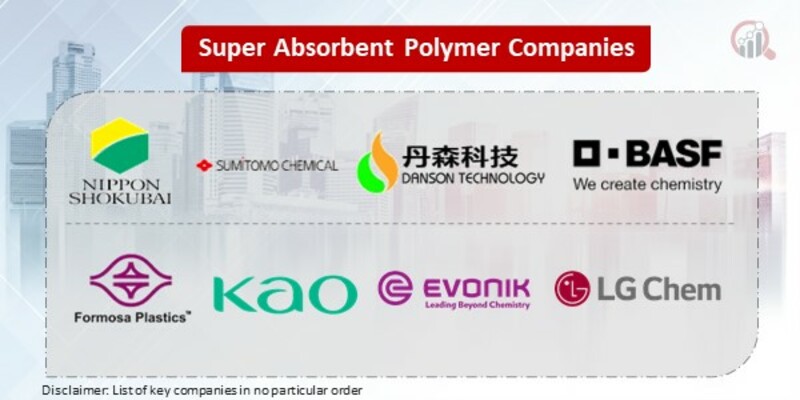Top Industry Leaders in the Super Absorbent Polymer Market

Super absorbent polymers (SAPs), those seemingly innocuous granules, hold a surprising amount of liquid – hundreds of times their own weight! This remarkable ability propels them to the forefront of a vibrant global market. Let's explore the strategic maneuvers, influential factors, and recent developments shaping this dynamic landscape where giants soak up market share alongside nimble innovators.
Strategies Absorbing Growth:
-
Feedstock Diversification: Moving beyond traditional petroleum-based SAPs, companies like Nippon Shokubai are exploring bio-based options derived from cornstarch or cellulose, responding to sustainability concerns and expanding feedstock security. -
Technological Twists: R&D labs are bubbling with advancements. Evonik Industries is pioneering new crosslinking techniques to improve SAP absorbency and durability, catering to demanding applications like agriculture and water management. -
Product Diversification: Leading players like BASF are going beyond standard hygiene-grade SAPs to develop specialized variants for niche applications like medical wound dressings and industrial spill management. -
Regional Expansion: Asia-Pacific, with its burgeoning baby care and hygiene industries, holds immense potential. Companies like Sumitomo Chemical are setting up production facilities in this region to capitalize on the local demand. -
Strategic Partnerships: Collaboration strengthens the flow. For instance, Sandia National Laboratories partnered with a diaper manufacturer to develop SAPs with built-in odor control, creating a game-changer for the hygiene market.
Factors Dictating Market Share:
-
Absorbency Prowess: Superior liquid holding capacity and gel strength are crucial metrics. Established brands like LG Chem have built reputations for consistent performance, attracting loyal customers. -
Cost-Effectiveness: Price remains a critical factor, particularly in mature markets. Chinese manufacturers often offer lower prices, challenging established players to optimize production and pricing strategies while maintaining quality. -
Regulatory Landscape: Stringent regulations on biodegradability and environmental impact dictate industry practices. Players who comply with these regulations, like Evonik with its closed-loop production cycles, gain a competitive edge. -
Application Diversity: Catering to diverse industries offers resilience. Companies with broad product portfolios like Dow Chemical benefit from diversification, mitigating risks in saturated segments.
Key Players:
-
NIPPON SHOKUBAI CO LTD
-
SUMITOMO SEIKA CHEMICALS CO LTD
-
Yixing Danson Technology
-
BASF SE
-
Formosa Plastics Corporation
-
Kao Corporation
-
Evonik Industries
-
LG Chem
-
SONGWON
-
Sanyo Chemical Industries
Recent Developments:
January 2022: Bharat Petroleum Corporation Ltd (BPCL) has established a new superabsorbent polymer technology demonstration unit of around 200 tonnes per year at the Kochi Refinery. With the use of the in-house acrylic acid as feedstock, the company’s super absorbent polymer technology has been used in several hygiene products including diapers and several incontinence products.
January 2022: BASF will increase innovation capabilities for its superabsorbent polymer business by building a state-of-the-art Superabsorbents Excellence Center at its Verbund site in Antwerp, Belgium.
September 2022: Sanyo Chemical Industries announced a significant breakthrough in the field of polymer technology through its wholly owned subsidiary, SDP Global Co. The company proudly announced the successful development of a novel superabsorbent polymer derived from biomass. This innovative achievement reflects Sanyo Chemical's commitment to sustainable and eco-friendly solutions, marking a notable stride in the utilization of renewable resources for polymer production. The development positions the company at the forefront of green technology within the chemical industry, addressing the growing demand for environmentally conscious alternatives.
February 2024: BASF marked a significant milestone with the initiation of production at its cutting-edge Superabsorbents Excellence Center in Antwerp, Belgium. This USD 27 million investment underscores the company's steadfast commitment to the hygiene business and its integral role within the acrylics value chain. The state-of-the-art pilot plant, equipped with the latest in data collection and sensor technology, aims to enhance innovation in superabsorbent polymers and expedite the transition from product development to large-scale production. Leveraging digitalization and advanced modeling, this facility is poised to boost product performance and, coupled with its proximity to BASF’s superabsorbent production in Antwerp, significantly reduce time-to-market.









